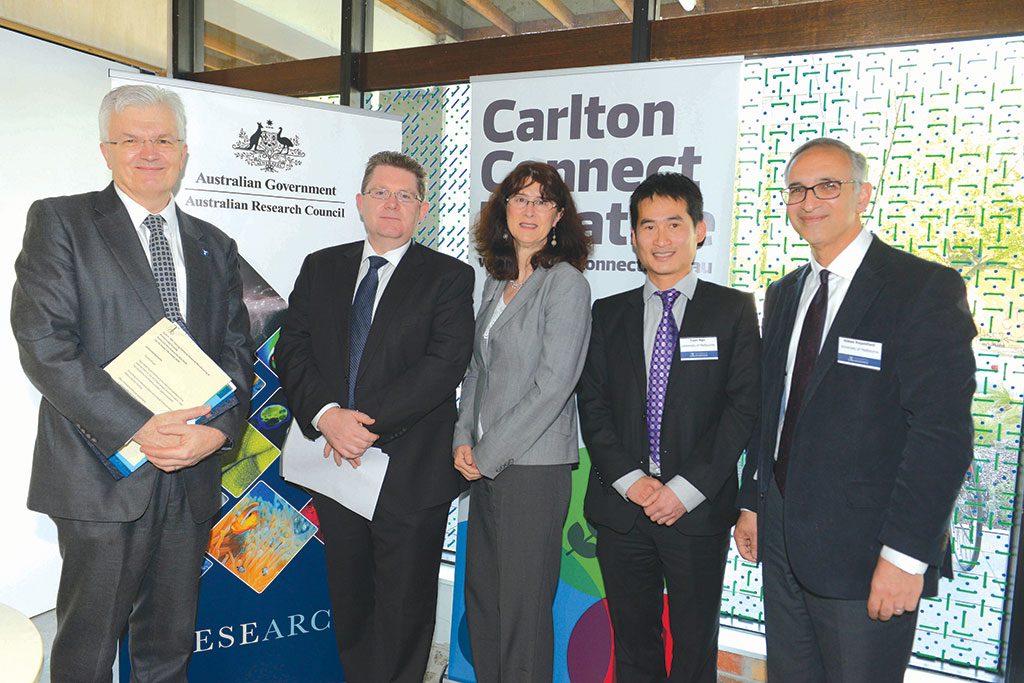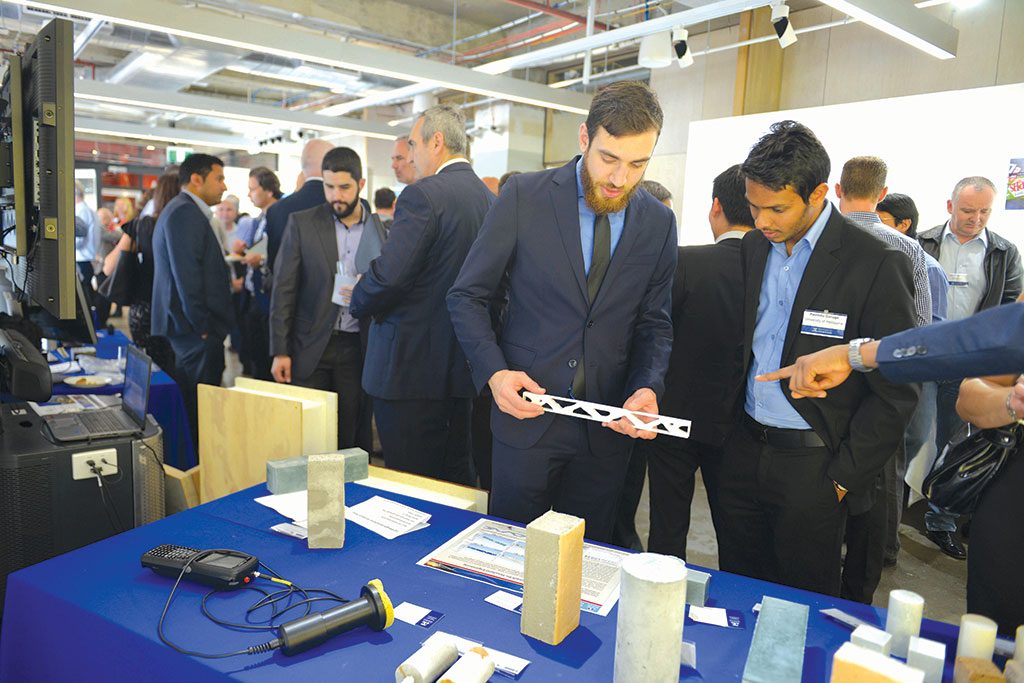CAMP.H OPENING MARKS NEW CHAPTER FOR INDUSTRY
THE OPENING OF THE ARC CENTRE FOR ADVANCED MANUFACTURING OF PREFABRICATED HOUSING (CAMP.H) ON FRIDAY 4 NOVEMBER AT THE UNIVERSITY OF MELBOURNE INNOVATION PRECINCT MARKED AN IMPORTANT MILESTONE FOR THE PREFAB INDUSTRY.
The Centre’s National Technical Manager Dr David Heath (BEng, PhD, MIEAust) described the launch as a highly successful event with strong high level attendance from around Australia.
STRONG INDUSTRY SUPPORT
“It was an honour having Senator Scott Ryan officially launch the Centre and hear him acknowledge the importance of being at the cutting edge of innovation and how the initiative can contribute to our country’s future.
Dr Fiona Cameron, Executive Director of the Australian Research Council, spoke of the ARC’s support for the program to provide training opportunities for higher degree by research candidates and postdoctoral fellows to drive growth, productivity and competitiveness in key industries. Vice Chancellor Prof Glyn Davis recognised the importance of bringing together expertise from institutions and industry to transform manufacturing and develop housing for the 21st Century. It was tremendous having this level of support and recognition of the impact that this initiative will have.”
Also presenting at the launch was Centre Director Prof Priyan Mendis, who spoke of the Centre’s evolution of over the past two years, along with Research Director A/Prof Tuan Ngo, who discussed the benefits of prefabricated construction and the many activities being run within the Centre. Chief Investigator Prof Colin Duffield noted the cultural shift of academic staff working closer with industry and the alignment between the Centre’s program and the objectives of the Federal Government’s National Innovation and Science Agenda. Partner Investigator Mr Tom Vassos spoke of the effort to change the construction methodology targeting government, building industry, finance industry and union movements to improve acceptance of prefabricated technologies.
“We feel that the calibre of not only the presenters but also of the audience, was a tremendous reflection on how industry values the research and training activities being undertaken in the Centre,” said Dr Heath.
With the Centre having already gained a reputation for providing a hub for prefabricated construction research in Australia, Dr Heath added that its significance was reflected by the level of industry participation; 12 Partners in total, including the peak industry body for the prefabricated construction, prefabAUS.
“Strong funding, cross-university partnerships and industry collaboration has created fertile ground for the development of innovative technologies to spur growth in Australia’s emerging prefabricated construction industry.”
“Industry is not only looking to the Centre to provide research and training for the next generation of professionals, but also to help grow manufacturing for the construction industry by developing new materials, processes and technologies. Moreover, with a strong focus on industry collaboration, there is an expectation that the Centre will be instrumental in helping to transform the construction industry to stimulate the economy through new employment opportunities and greater productivity.”
Approximately 130 people attended the Centre launch, including a diverse spectrum of representatives from the building and construction industry ranging from architects, engineers, academic researchers, builders, and various members from the supply chain. There was also representation by government bodies, peak industry bodies such as Master Builders Association of Victoria and Forest and Wood Products Australia, as well as academic researchers from around Australia.
“An advanced knowledge in innovative materials and technologies relevant to prefabricated construction will equip the next generation of professionals with the skills to seed the building and construction industry to grow prefabricated construction.”
Dr David Heath (BEng, PhD, MIEAust)
“The event marked an important milestone in terms of recognising not only the tremendous effort behind the Centre’s two-year gestation, but also the enthusiasm and level of support from the building and construction industry for the success of the initiative,” said Dr Heath.
“Industry transformation is an ongoing effort so the lobbying continues, but the launch was a clear indication that there is a strong appetite for change.”
NETWORKING, INFORMATION SHARING + RESEARCH
In addition to the formal proceedings, the event included opportunities for networking to promote collaboration and to increase awareness of the research and training activities being undertaken in the Centre.
“There are few events that attract such a diverse range of stakeholders in the building and construction industry, so this was an excellent opportunity to learn about industry’s needs and showcase what can be achieved.”
A number of displays from postdoc and PhD students were an excellent opportunity to showcase the breadth and depth of talent among the Centre’s research team, Dr Heath confirmed. “Researchers were able to bring tactile demonstrations to share details of their research expertise. The displays were also an excellent opportunity to raise the profile of the many activities being undertaken within the Centre and an opportunity for key stakeholders to directly engage with members of the Centre’s team.”
The research talent on show reflected an important focus for the Centre, said Dr Heath, with the Centre having awarded funding by the Australian Research Council as an Industrial Transformation Research Program (ITRP) in recognition of training being a key focus.
“An advanced knowledge in innovative materials and technologies relevant to prefabricated construction will equip the next generation of professionals with the skills to seed the building and construction industry to grow prefabricated construction.”
“The Centre’s Research and Training Committee comprises Chief Investigators from the collaborating universities and Partner Investigators from the collaborating partners. During the afternoon following the official launch, the Research and Training Committee met to discuss the many research projects being run within the Centre, current trends within the prefabricated housing industry and opportunities for further collaboration.”
A PROMISING FUTURE
“The Centre has been more than two years in the making and is the product of a tremendous collaboration that has been spearheaded by Centre Director Prof Priyan Mendis and Research Director A/Prof Tuan Ngo.”
“There is a very positive outlook for the future of prefabricated construction evidenced by a high level of interest in the launch event and strong industry collaboration that we have been able to achieve. We are most grateful for the support that we have received from the Australian Research Council and our many industry partners. Without this support the Centre would not have been possible. Given the various government initiatives promoting innovation and our growing need for more affordable housing, industry is looking to prefabricated construction to provide smarter solutions.”
“There is a very positive outlook for the future of prefabricated construction evidenced by a high level of interest in the launch event and strong industry collaboration that we have been able to achieve.”
Dr David Heath (BEng, PhD, MIEAust).
“The Centre is now on a four-year journey to unlock potential in Australia’s building and construction industry to boost prefabricated construction in Australia and we look forward to working closely with industry to develop innovative solutions and train experts in the various technologies and processes needed for prefabricated construction.” ■









